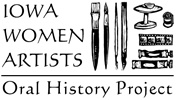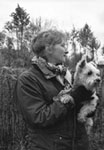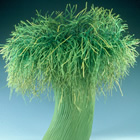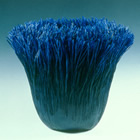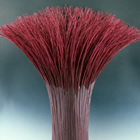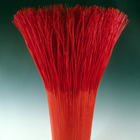MARY MERKEL-HESS
artwork | audio | statement | galleries
artwork
audio 
- Early interest (60 sec. | 408KB): listen | read
- College (60 sec. | 409KB): listen | read
- Making a living (46 sec. | 316KB): listen | read
- Artwork (64 sec. |435KB): listen | read
- Process (60 sec. | 408KB): listen | read
- Favorite piece (43 sec. | 295KB): listen | read
artist statement
I make baskets using a technique that I developed, a combination of three-dimensional collage and papier mache. The vessels are made over molds. Small pieces of paper are applied with glue to the mold and allowed to dry, thus creating a paper form that is removed from its mold and further manipulated. Over the years, I have discovered many variations of this technique. I have used thin and thick papers, varied the shapes, and included paper cord, reed, or fiber in the body of the vessels. I have made interior forms for the baskets and then covered them with a "skin" of transparent paper.
I make vessels because I am fascinated with form and structure. I look for inspiration in the natural world, and then allow technique to mesh with these visual ideas to create something new. I enjoy all aspects of this process: the appreciation of the world around me that suggests ideas and the search for a method of construction that allows my ideas to take shape.
audio text
Early interest
The one thing I remember as being really formative was that there was a statewide postcard project, and once a month you got this postcard of a famous work of art. I remember Starry Night by van Gogh, Fall Plowing by Grant Wood—there were a whole bunch of them. And you had a notebook. So you got your postcard, which was a tremendous treasure, you pasted it into your book, and then as a class you wrote an essay together about this work of art. I just longed for that experience, and was always bitterly disappointed if we ended up without time to do it or something. This only went on one year, I remember, and then the project was canceled. I was heartbroken. I went on then; I started my own notebook—wherever I could find a picture in a magazine or print of a famous work of art—and I would paste it in and write down the artist.
I started doing paintings in high school, and my dad always framed them and hung them. And I sold paintings to other people, too. Since I was about ten or eleven, I could draw exactly.
College
I didn't understand how to be an artist. I didn't want to be a commercial artist, I knew that. So then I didn't know what other choices were there. I went, then, to a university, which is a silly choice in a way; it didn't even have an art program—and I majored in philosophy and sociology.
Then after I graduated from Marquette, I'd been reading philosophy with one of my professors, and he advised me to go to the University of Wisconsin-Milwaukee, and take a few phil. courses. And so I went over there, signed up for a course, and I also signed up for a drawing course. Well, by not even halfway into the semester, I dropped the phil. course. And I had decided to become an artist, which is odd, because at this point, I already have a B.A. I've got no art credits. I'm really starting over at 22, but that's what I did. In a sense, I didn't envision what I was going to do then, either, but I didn't care. I felt all this rapport with artists that I met.
Making a living
I couldn't conceive of being an artist if I couldn't make a living at it. It just wasn't an option that I would say I was an artist and never do anything. And I taught once at Cornell briefly. I did something at Kirkwood. I did workshops. I did shows. I did art fairs. I did everything within my environment that I could grab onto. So I did a body of work and I went to the American Craft Enterprises and other big art fairs. So then I started going to the East Coast where the really big galleries are. I didn't really have help; I had to do this by myself. So after about five years of this, which I think was probably the hardest time in my life, because I hated it so much. What it led to was the situation I'm in now, where I have galleries and I stay at home and send my work out.
Artwork
I call myself a basket-maker. It's really taking the vessel form, the basket material, or the technique—some basketry technique—and using it in a more sculptural way. That's what contemporary basketry is. I started out doing these papier-mâché vessels, which were somewhat similar to these large folded metal vessels. I was using very thin metal and folding them, and paper was sort of a suggestible medium at that point. I thought of myself as a metalsmith, and doing these things on the side. But the baskets made a big hit. Galleries approached me, people approached me. I started entering them in shows, and I won some very big prizes with them, and I thought, I don't know what's going on in fiber, but I should find out, because they're interested in what I'm doing. So after three or four years of doing both metal and fiber, I eventually just went to fiber. I use paper and reed, primarily. But I have taken these little side trips and used museum board and gampi paper, so I use what I need to make my shapes.
Process
It usually starts with some sort of image, which could be very abstract. It might be a line of a grass, sometimes it's just a color, sometimes it's something about the quality of a whole landscape. And any inspiration I get, I usually feel has to result in more than one piece. Because a life of constant creativity, you can't afford to pass up any good ideas. And then I usually go and make a scale drawing of the mold I'm going to build, or of the basket as I want it to be, or both. And sometimes I'll have an inspiration for a long time without being able to think how to make the shape. So I have a notebook where I keep these things. And then I build the mold. Then I make layer upon layer of paper with these inclusions of reed or cord or whatever, and build it up. Eventually it comes off the mold, and then it needs to be shaped and painted. And I go through periods of using lots of color and then using no color and just concentrating on the form.
Favorite piece
My favorite piece—I don't have it anymore, I sold it and I don't even know where it is, but—it's a reed piece, you can't see any paper. It's perhaps two and a half feet tall, the reeds come up straight, and they bend inward, and they sort of fold down together, down through the center of the vessel. So there's two sides; each side is the same. It's a very thin, flat piece. And it's called Inward, and it represents for me what I'm most interested in and after in my work which is this sense of tranquility and containment and peace. So I thought that was my most successful piece. Not everything I do is so tranquil, but that piece I really, really liked.
